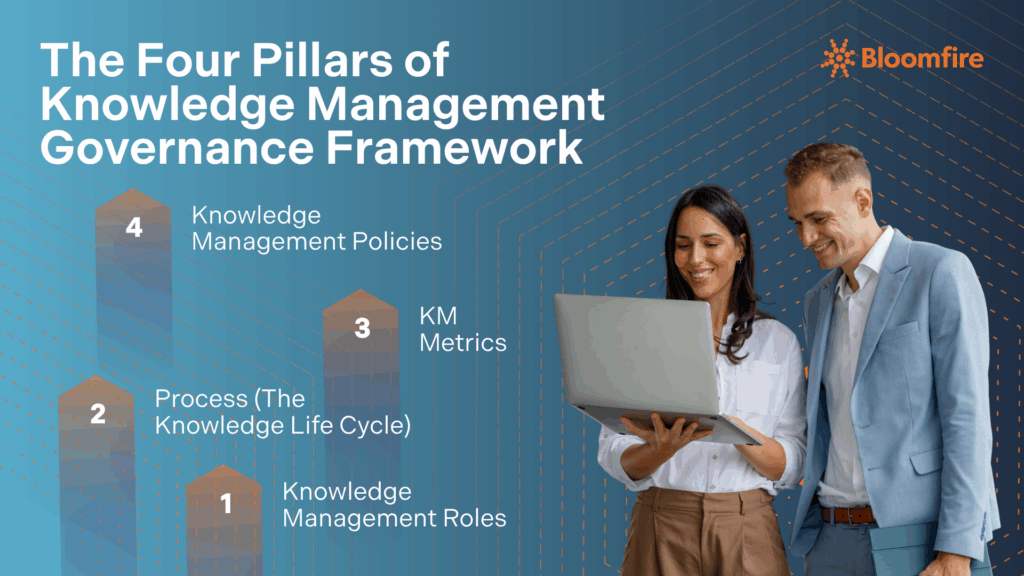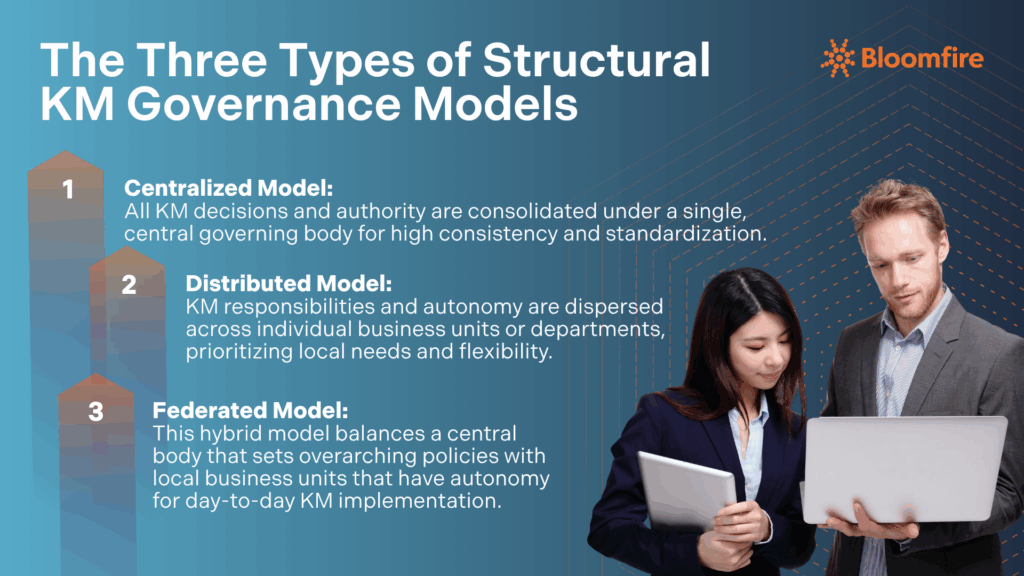Knowledge Management Governance Models: Framework, Types, and Formation

The rapid deployment of artificial intelligence (AI) is pressuring customer service and support leaders to deliver faster resolution times and better self-service. However, many organizations realize their current knowledge management (KM) programs and tools are insufficient to supply accurate, relevant content to these sophisticated AI systems.
Launching a knowledge base without sufficient knowledge management governance puts the entire program’s success at risk, hindering adoption. It also makes results difficult to measure and ultimately prevents productivity gains from Generative AI (GenAI).
Proper governance is crucial to ensure knowledge programs support both human and AI needs. Below, we outline the framework, types/models, and creation process of a knowledge management governance approach based on recent data from Gartner Research.
Summary
- The four pillars of a knowledge management governance framework are: KM roles, process, metrics, and policies.
- Knowledge management governance models fall into three types: centralized, distributed, and federated.
- Creating a KM governance strategy involves establishing a governance committee, assessing current KM activities, drafting the framework, and evaluating its progress while continuously adapting to changes.
The Four Pillars of Knowledge Management Governance Framework
The cornerstone of a successful KM program is a robust knowledge management governance framework. This framework must keep content programs aligned with business objectives, driving efficiency and reducing cost per answer. It defines the resources, goals, objectives, and metrics required for the program.

1. Knowledge Management Roles
Knowing who is responsible for knowledge management is the first step in setting up this committee. There are fundamental roles within the KM governance committee responsible for oversight, adoption, and process. Key positions include:
- Executive sponsor: Aligns senior stakeholders and secures resources
- Knowledge program manager: Defines roles, processes, and policies
- Knowledge management coach: Reinforces good practices with agents
Recent data highlights the urgency of involving senior leadership in this process: A McKinsey Global Survey found that 28% of organizations using AI reported that their CEO is responsible for overseeing AI governance, while 17% said their board of directors oversees it. It emphasizes that KM governance, which is critical to the quality of content fueling AI, is now viewed as an executive-level accountability, not just an operational task.
2. Process (The Knowledge Life Cycle)
This pillar defines the documented process for creating, improving, publishing, and retiring knowledge assets. It addresses critical questions, such as who has permission to create content and which review permissions are required. A key consideration for AI is restructuring long-form documentation into templates suitable for AI ingestion.
To ensure speed and accuracy, the knowledge management governance committee must also define the structure of the knowledge assets, as many older programs use long-form documentation that is unsuitable for GenAI ingestion. Understanding the stages of the knowledge management cycle is essential for defining this process.
Agents must also receive adequate training on the documented life cycle process. Additionally, the committee must ensure that any changes to this process are communicated quickly and clearly.
3. KM Metrics
A critical function of the governance committee is determining how success will be measured and communicated, aligning with company and functional business objectives. This includes measuring operational impacts from knowledge capture and reuse, and tracking team/individual participation.
The complexity of preparing content for AI is a growing challenge. For instance, 45% of surveyed enterprises already have officially recognized AI platforms for employees to use, yet more than half (54%) of them still lack a complete or ongoing AI governance framework or policy. Without governance defining the AI-ready process, legacy, long-form content will continue to be unsuitable for effective GenAI deployment, risking inaccurate outputs.
4. Knowledge Management Policies
These are the rules —such as publisher role criteria and policies on adoption—that govern the program. They ensure consistent execution and efficient decision-making. An organization’s ability to enforce its KM policies directly impacts its success with AI.
Recent survey data reveals that, while many companies are heavily investing in AI, governance is lagging: only 43% of surveyed organizations have a formal AI governance policy in place, with almost a third (29%) having none at all. This gap is critical because absent or poor policies expose the organization to significant risks around data privacy, intellectual property leakage, and regulatory non-compliance (e.g., GDPR, CCPA).
Clear policies, therefore, are the non-negotiable guardrails that protect the organization and build the trust required for scalable, effective knowledge management.
Three Types of Structural KM Governance Models
The structural approach an organization takes to authority is essential. While the document focuses on the formation of governance, widely adopted KM governance models fall into three types based on the distribution of power:

1. Centralized Model
All KM authority and decision-making is consolidated in a single, dedicated team or office. This model offers high consistency and standardization, which can be useful when a uniform approach to knowledge management is paramount.
In this model, the governing body, often the knowledge program manager and executive sponsor, maintains tight control over the entire knowledge lifecycle, including article creation, review, and publishing permissions. This approach is often favored by organizations in highly regulated industries, such as pharmaceuticals or finance, where absolute accuracy and compliance with legal requirements are non-negotiable.
The benefit of this centralized control is that it minimizes the risk of outdated or non-compliant content persisting in the system. However, this structure can introduce complexity and publishing delays if the centralized review process becomes a bottleneck for the high volume of content required by service agents
2. Distributed Model
KM responsibilities and autonomy are spread across different business units or functional departments. This offers flexibility to meet local needs, ensuring each department’s content is perfectly tailored to its unique audience. However, such flexibility can complicate cross-organizational searching and make it difficult for a central KM team to enforce a single, high-level standard for metadata or accuracy across the Enterprise Intelligence. This ultimately leads to isolated information silos and can undermine the goal of unified, efficient knowledge delivery.
The distributed model is particularly common in large, diverse corporations with distinct business units (e.g., banking, insurance, and asset management) or highly specialized functions (e.g., HR, Legal, and R&D). For example, a global manufacturing company might allow its engineering department to adopt a highly technical, long-form document template for its knowledge articles.
Meanwhile, the customer support department uses a shorter, more task-oriented template to directly feed a customer-facing chatbot. This highlights the need to choose the right type of knowledge management systems to support the structure.
3. Federated Model
This structure is a hybrid knowledge management governance model that provides a central body for setting high-level policies and standards (for consistency) while granting individual business units autonomy to manage and implement KM practices for their domain (for flexibility).
An ideal example of the federated model’s application in the AI era is the management of a global knowledge base for a multinational financial services firm. A central KM governance committee, including representatives from IT, Legal/Compliance, and the AI team, would establish universal policies on data security and intellectual property rights, as well as technical standards for making knowledge articles AI-ready.
However, the local investment banking unit is granted autonomy to define its own content creation process and review cadence for proprietary trading information. On the other hand, the retail banking unit tailors its processes to enable service agents to create and publish solutions to common customer issues quickly. This balance ensures that highly sensitive or regulated content adheres to a strict global standard, but time-sensitive, domain-specific information can be managed with the agility required by that business unit.
The federated approach also aligns with the core principles of enterprise intelligence, which emphasize weighing central strategy with decentralized action.
The Four Steps of Knowledge Management Governance Creation
Leaders must follow a four-step cycle to establish knowledge management governance that supports human and AI agents. This cycle is an ongoing framework, not a one-time project, ensuring the program remains dynamic and aligned with evolving business needs. Here are the KM governance steps to consider:

Step 1: Establish a Governance Committee
The first step is forming a committee with knowledge workers and stakeholders. This move ensures cross-functional expertise and executive support to oversee the program’s adoption and process. The answer to “Who is accountable for the program’s success?” must be clear.
The initial selection of committee members is critical for setting the program up for success. Executive stakeholders must champion the committee and coordinate communication between departments to ensure a broad input into the KM governance process for content creation and updates. Without the right mix of skills and experience, the KM governance may suffer from blind spots in critical areas.
Step 2: Conduct Assessment of Current Activities
The committee must assess the current program to identify what is working, what is missing, and opportunities for improvement. This includes evaluating the chosen methodology, the required roles, the review frequency, and the success measures.
When examining methodology, questions should be asked about the technical, process, and cultural challenges that must be overcome. Address whether current systems support the approach (or if new systems are required).
For role considerations, the committee must determine if it possesses the right skill sets to execute the chosen methodology. The evaluation should also answer how AI, including GenAI, might change how existing roles perform KM tasks. This evaluation is vital for defining your overall knowledge management strategy and choosing an appropriate knowledge management methodology.
Considering review frequency means deciding how to balance knowledge publication velocity for faster circulation while improving quality, primarily based on content type and compliance requirements. Finally, for success measure considerations, the team must clearly articulate which company and functional business objectives the KM program supports and how they will measure operational impacts and participation.
Step 3: Draft a Governance Framework
Use the assessment results to draft the new knowledge management framework. This step answers the question: “How will people, process, and technology come together to support the program’s objectives?” The assessment’s findings are codified into actionable documentation. The draft must clearly map the four pillars (Roles, Process, Measures, Policies) onto the program’s core objectives.
The framework ensures alignment and prevents complexity, duplication, and inconsistency that arise without established governance. It ultimately guides every employee’s participation and dictates how the organization recognizes and integrates KM into its culture. The final framework will guide the implementation of the chosen knowledge management system.
Step 4: Evaluate Progress and Adapt
Continuously evaluate the results of the governance structure against metrics and adapt to address pain points. The committee should periodically review governance requirements throughout the program’s life cycle. This continuous loop is a key indicator of your organization’s Enterprise Intelligence Maturity Index level.
To keep the governance committee engaged and mission-focused, it is essential to reinforce and publicize the positive impact of a well-governed KM program. This includes sharing evidence of improvement in customer experience, better service metrics, and faster resolution times for issues addressed by a published article. Evaluating progress also means continually adapting the governance to changes in business objectives and pain points.
Driving Governance Success: KM Culture, Coaching, and AI Assistance
Creating a knowledge-centric culture takes time, but it ensures a lasting impact. Leaders must focus communications on selling the change to the organization and reinforcing the right behaviors through coaching. Success hinges on agents’ willingness and ability to leverage existing knowledge to solve recurring issues. Furthermore, the program’s evolution should leverage AI as a governance assistant through an AI-powered knowledge management platform.
Govern Your KM Strategy
Learn to formalize KM ownership and processes to drive maximum business value.
Consult Our Experts

How to Improve Customer Service in Call Centers: 21 Ways to Enhance Contact Center Experience

Innovative Ways Companies Are Using Knowledge Management

How to Implement a Knowledge Check in 6 Steps

Estimate the Value of Your Knowledge Assets
Use this calculator to see how enterprise intelligence can impact your bottom line. Choose areas of focus, and see tailored calculations that will give you a tangible ROI.

Take a self guided Tour
See Bloomfire in action across several potential configurations. Imagine the potential of your team when they stop searching and start finding critical knowledge.
